Across Asia, communities welcomed 2025 with spectacular fireworks shows, special events and cheering crowds.



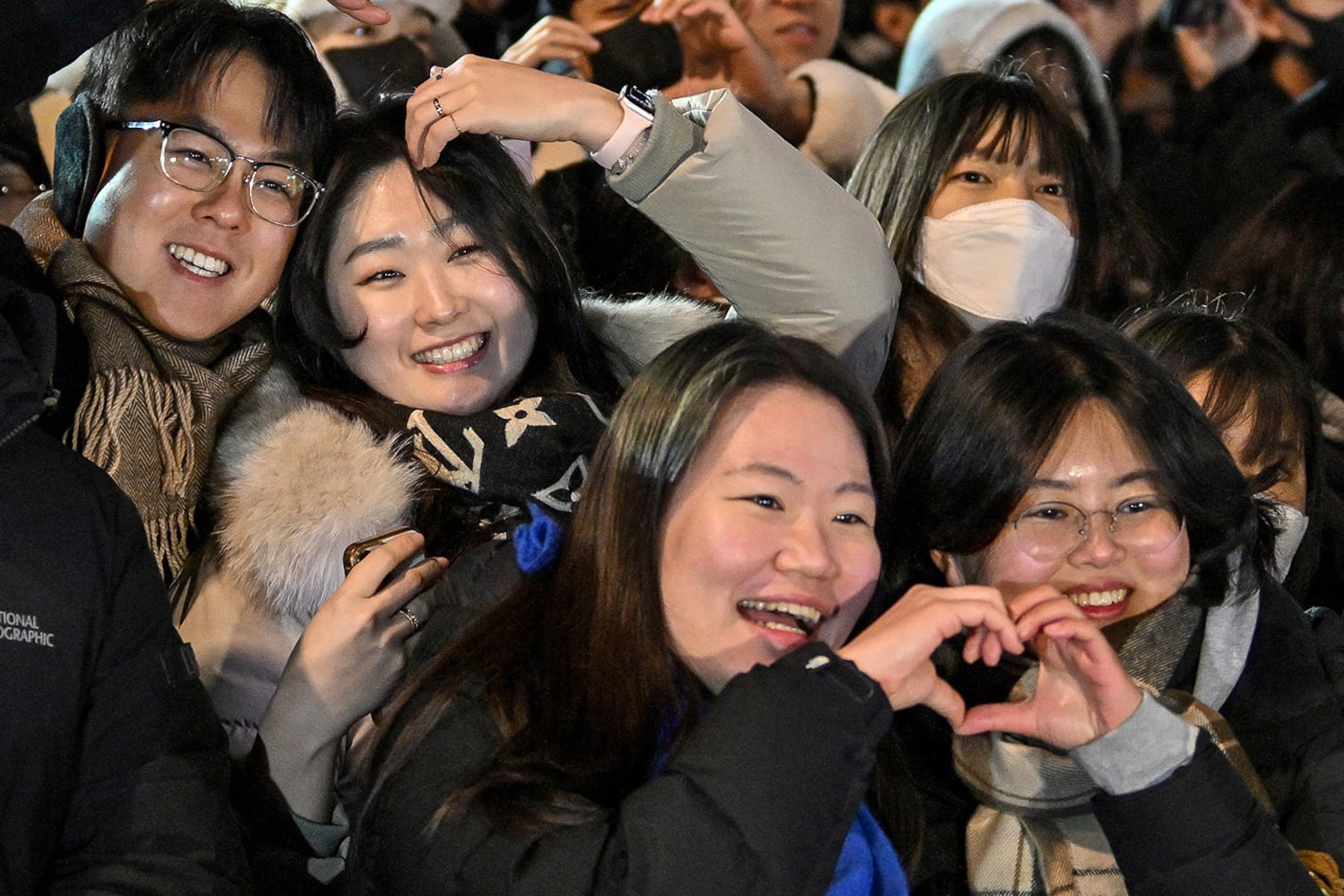




This content originally appeared on Radio Free Asia and was authored by Paul Nelson.
This post was originally published on Radio Free.
Across Asia, communities welcomed 2025 with spectacular fireworks shows, special events and cheering crowds.








This content originally appeared on Radio Free Asia and was authored by Paul Nelson.
This post was originally published on Radio Free.
Comprehensive coverage of the day’s news with a focus on war and peace; social, environmental and economic justice.
The post The Pacifica Evening News, Weekdays – December 31, 2024 appeared first on KPFA.
This content originally appeared on KPFA – The Pacifica Evening News, Weekdays and was authored by KPFA.
This post was originally published on Radio Free.
This content originally appeared on Just Stop Oil and was authored by Just Stop Oil.
This post was originally published on Radio Free.
Read RFA’s reporting of this story in Chinese
Police in Manchester were called to the Chinese consulate over the weekend after staff started an altercation with a Radio Free Asia journalist who filmed them cleaning up Hong Kong protest graffiti on the street outside.
Four members of staff surrounded RFA Cantonese Service reporter Matthew Leung on Saturday afternoon after he started taking photos of them scrubbing away slogans in white paint daubed on the sidewalk outside the Chinese consulate on Manchester’s Denison Road.
The slogans read “F— PRC!” [People’s Republic of China] “Independence for Hong Kong!” and “Long Live the Republic of China!” the official name for democratic Taiwan, according to photos shared on the messaging app Telegram on the afternoon of Dec. 28. There was also an epithet referring to China by a highly offensive historical slur, which has been used by Hong Kongers in protest slogans before.

A Telegram user said they had painted the slogans, “because they are communists.”
Staff moved quickly to scrub the graffiti away, but threatened RFA reporters who arrived and started taking photos at the scene.
“We know your name, we know your address,” one warned RFA’s reporter. “I know our rights — if you take photos of us, we have image rights.”
“We don’t want any photos or videos to appear on the Internet. If you publish them, we will notify the police,” one staff member said.
The Chinese Consulate in the northern British city made headlines in 2022 after Consul General Zheng Xiyuan assaulted a Hong Kong protester inside the Chinese consulate in Manchester.

There are also growing concerns over Chinese Communist Party infiltration of all aspects of British life, and warnings from Hong Kongers in exile over growing acts of violence by Beijing’s supporters and officials alike.
Overseas activists frequently report being targeted by agents and supporters of the Chinese state, including secret Chinese police stations in a number of countries.
RELATED STORIES
Chinese consul general in Manchester admits to pulling Hong Kong protester’s hair
China recalls six diplomats asked to waive immunity over Manchester consulate attack
UK Confucius Institutes enable ‘transnational repression,’ study says
Another staff member, who spoke accented Cantonese, said: “Stop shooting; we’re calling the police now,” while another staff member repeated the demand in English.
One staff member tried to gain access to the digital touchscreen of the camera, despite a verbal complaint from the RFA journalist, but was eventually pulled away by colleagues.
Staff also demanded that the RFA journalist identify themselves, which the reporter did, showing an official National Union of Journalists press accreditation.

“This is the Consulate General,” said one of the men, to which the reporter replied that he was standing on a public footpath.
“If you want to shoot, you have to get our permission,” the man retorted, citing “diplomatic privileges under the Vienna Convention.”
When the police arrived after being called both by the RFA reporter and consulate staff, they took away a bag of evidence, and reminded consular staff that journalists have a right to film in public places.
They questioned everyone at the scene, including asking the RFA reporter if they saw who painted the slogans, then left.
They initially told RFA Cantonese they would investigate the graffiti as a “hate crime,” but later said that they wouldn’t be pursuing an investigation because consular staff at “refused to cooperate.”
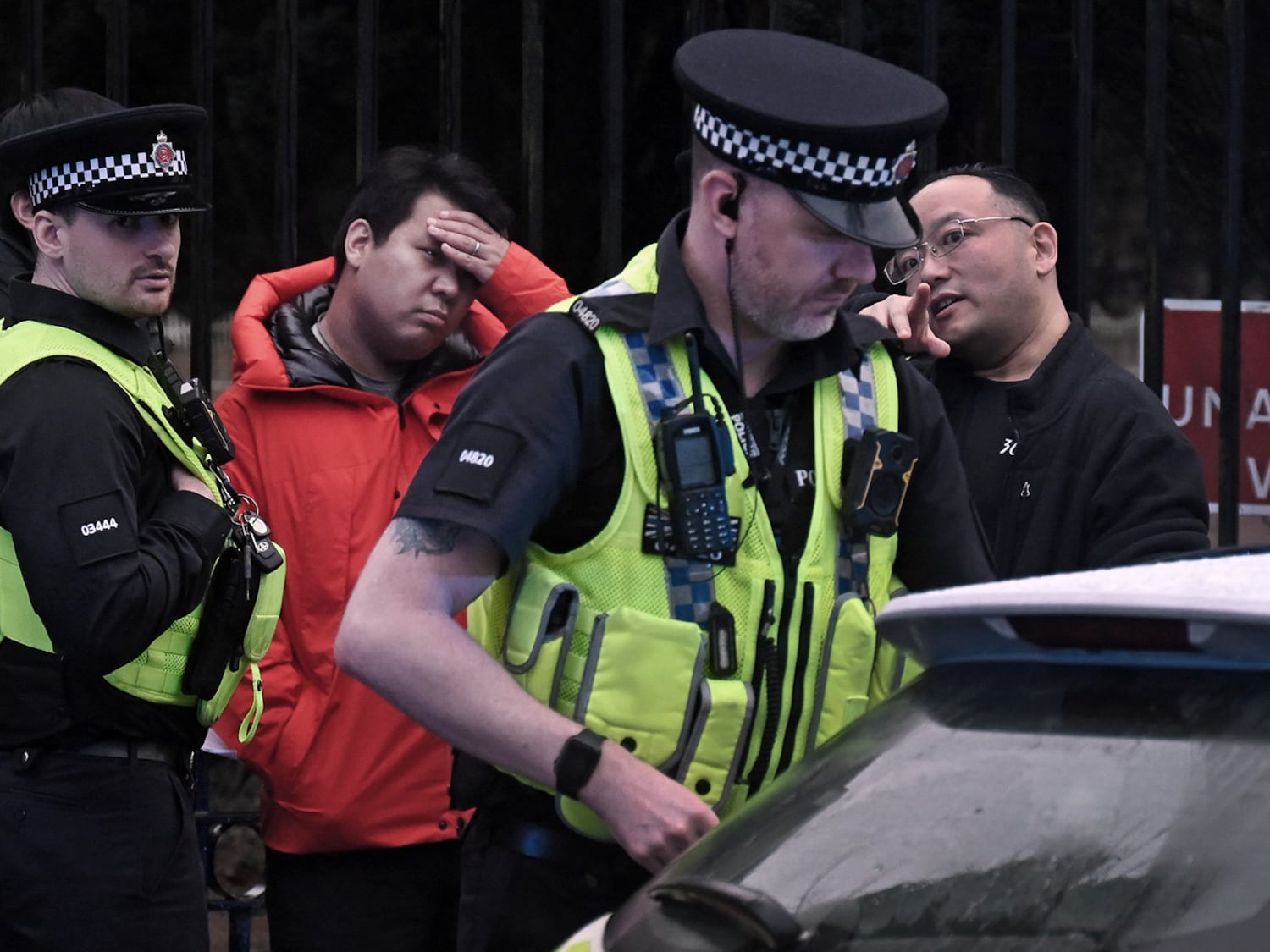
Simon Cheng, founder and chairperson of the advocacy group Hongkongers in Britain, said the move appeared to be a bid to control media activities on British soil.
“At the very least, it can be said that the consular staff have no sense of their own legal rights or boundaries,” Cheng said. “More importantly, if they start applying China’s method of restricting media freedom and blocking filming in the UK, that’s definitely a form of transnational repression.”
Hong Kong exile groups in the United Kingdom have hit out at alleged transnational repression by the Chinese Communist Party on British soil after a church in the southern British town of Guildford canceled a children’s workshop on justice, civil liberties and human rights in 2023.
Cheng said the staff appeared to have toned down their approach following an incident in 2022, which saw six Chinese diplomats including the Consul General withdrawn after an attack on Hong Kong protester Bob Chan.
“There are slight differences in the way they handled it … they appeared to be de-escalating and threatening to call the police, but that doesn’t mean they had any legal grounds or justification for doing so,” Cheng said.
He said the graffiti expressed simmering anger among Hongkongers in the U.K. at China’s ongoing crackdown on public dissent and political opposition in Hong Kong, but called on protesters to “express their demands in a legal manner.”
Translated by Luisetta Mudie.
This content originally appeared on Radio Free Asia and was authored by Matthew Leung and Jasmine Man for RFA Cantonese.
This post was originally published on Radio Free.
Comprehensive coverage of the day’s news with a focus on war and peace; social, environmental and economic justice.
The post The Pacifica Evening News, Weekdays – December 30, 2024 appeared first on KPFA.
This content originally appeared on KPFA – The Pacifica Evening News, Weekdays and was authored by KPFA.
This post was originally published on Radio Free.
Read more on this topic in Vietnamese
Vietnam announced on Dec. 12 it was standing as a candidate for re-election to the United Nations Human Rights Council for 2026-2028. It had a seat on the U.N. body in its 2014-2016 and 2023-2025 terms.
Vietnam’s desire to remain on the Human Rights Council, or HRC, comes in spite of criticism from international groups such as Human Rights Watch, which describes its record on rights as “dire in virtually all areas.”
“Basic rights are severely restricted, including freedoms of expression, peaceful assembly, association, and religion. Rights activists and bloggers face police intimidation, harassment, restricted movement, arbitrary arrest, and detention,” the group says on its Vietnam country page.
Western governments have also criticized Vietnam, with the U.S. State Department noting “arbitrary or unlawful killings by the government; torture or cruel, inhuman, or degrading treatment and punishment by government agents,” among a long list of criticisms.
Why does Vietnam want to remain on the UNHRC?
Nguyen Dinh Thang, director of Vietnam human rights group BPSOS, told Radio Free Asia that Vietnam’s bid was aimed at proving to its people that it had a good reputation on the international stage.
“Secondly, they have a permanent platform at the UNHRC to push back against criticism and condemnation from the governments, U.N. human rights institutions, as well as human rights defenders,” he said.
RELATED STORIES
Rights group urges govts to reconsider funding Vietnam energy plan
US tech giants face human rights concerns over Vietnam investments
Activists call on Vietnam’s top leader to honor rights commitment
Activist Nguyen Tien Trung said human rights have historically been a barrier to closer ties with the U.S. and other democratic countries. He told RFA a third term on the UNHRC would improve Vietnam’s chances of building closer economic and trade ties with the West.
What are Vietnam’s responsibilities?
As a member of the HRC Vietnam must listen and respond to reports of human rights violations by the U.N.’s special rapporteurs. According to BPSOS’s Thang, activists also have a better case for pushing the international community to increase pressure on Hanoi to live up to the commitments it made on becoming an HRC member.
As a UNHRC member, Vietnam must adhere to all responsibilities outlined in the UN’s Resolution 60/251. It mandates that members uphold the highest standards in promoting and protecting human rights, both domestically and internationally. During both their candidacy and tenure, members are required to make and fulfill commitments to improve the human rights situation in their countries.
In addition, members must cooperate with the UNHRC, including in facilitating special procedures, responding to investigation requests and providing necessary information. They must also participate in a Universal Periodic Review, or UPR, for evaluation and commit to fully implementing its recommendations.
How has Vietnam performed as a member of the UNHRC?
In September, speaking at the UNHRC session to adopt the Universal Periodic Review Outcomes, Human Rights Watch said Vietnam’s commitments were empty promises.
“We are gravely disappointed that among the 49 recommendations not accepted by Vietnam, many of them are directly related to human rights defenders, including several calling for the release of human rights defenders imprisoned for exercising their fundamental rights,” the group said.
“As of September 2024, Vietnam had at least 171 political prisoners and at least 21 political detainees pending trial—all of whom were prosecuted for the peaceful exercise of their civil and political rights.”
Since it became a UNHRC member for the second term in 2023, Vietnam has consistently been listed among countries with the poorest performance in international human rights rankings. Freedom House ranked it “not free,” scoring only 22/100 in its internet freedom index over the past five years.
The CIVICUS alliance rates Vietnam’s civic space “closed” with its unwavering crackdown on social activists.
Vietnam also remains on the U.S. State Department’s Special Watch List which covers countries where the government engages in or tolerates “particularly severe violations of religious freedom.”
Why was Vietnam re-elected?
Despite its poor human rights record, Vietnam was re-elected to the UNHRC with the backing of 145 out of 189 U.N. members, beginning its second three-year term on Jan. 1, 2023.
It is not the only country on the body with serious rights violations. China and Cuba are both members until 2026. Russia was a member but was suspended in April 2022 following its invasion of Ukraine and later withdrew from the council.
Experts told RFA the HRC’s election mechanism is the reason for Vietnam’s two successful elections since self-nominating states do not have to list their human rights achievements.
The election mechanism is based on geographical allocation. The UNHCR’s 47 seats are distributed among five regions: Africa, 13 seats; Latin America and the Caribbean, eight seats; Western Europe, seven seats; Eastern Europe, six seats, and Asia-Pacific with 13 seats.
Geographical allocation aims to prevent membership concentration in regions and countries and ensure equal opportunities for all countries. However, it is often criticized as a loophole allowing countries with poor human rights records to secure a UNHRC seat.
BPSOS’s Thang pointed out that when a region has few candidates, the chances of self-nominated countries winning are almost guaranteed.
During the UNHRC election for 14 seats in November 2022, the Asia-Pacific had four vacancies but only six candidates. With Vietnam the sole candidate from Southeast Asia, there was little competition.
Secondly, the closed voting mechanism enables authoritarian countries to support one another despite pressure from human rights organizations or the international community.
“The majority of Asian countries are authoritarian and the authoritarian regimes often vote for each other,” explained Nguyen Tien Trung.
“This explains why, despite a poor, if not the worst, human rights record in almost all categories, the Communist Party of Vietnam has always won in the race to the Human Rights Council.”
Vietnam is making full use of the election mechanism during its candidacy for the 2026-28 tenure.
“Vietnam will not need to do much to be re-elected as a member of the UNHRC,” said Thang. “They only need to negotiate with other countries and call on them to vote for Vietnam.”
Translated by Anna Vu. Edited by Mike Firn.
This content originally appeared on Radio Free Asia and was authored by RFA Vietnamese.
This post was originally published on Radio Free.
This content originally appeared on Just Stop Oil and was authored by Just Stop Oil.
This post was originally published on Radio Free.
This content originally appeared on Just Stop Oil and was authored by Just Stop Oil.
This post was originally published on Radio Free.
This content originally appeared on Radio Free Europe/Radio Liberty and was authored by Radio Free Europe/Radio Liberty.
This post was originally published on Radio Free.
This content originally appeared on Laura Flanders & Friends and was authored by Laura Flanders & Friends.
This post was originally published on Radio Free.
Comprehensive coverage of the day’s news with a focus on war and peace; social, environmental and economic justice.
The post The Pacifica Evening News, Weekdays – December 27, 2024 appeared first on KPFA.
This content originally appeared on KPFA – The Pacifica Evening News, Weekdays and was authored by KPFA.
This post was originally published on Radio Free.
This content originally appeared on The Grayzone and was authored by The Grayzone.
This post was originally published on Radio Free.
This content originally appeared on Democracy Now! and was authored by Democracy Now!.
This post was originally published on Radio Free.
Comprehensive coverage of the day’s news with a focus on war and peace; social, environmental and economic justice.
The post The Pacifica Evening News, Weekdays – December 26, 2024 appeared first on KPFA.
This content originally appeared on KPFA – The Pacifica Evening News, Weekdays and was authored by KPFA.
This post was originally published on Radio Free.

His name might not be familiar to many, but his songs are sung by millions around the world. Today, we take a journey through the life and work of Yip Harburg, the Broadway lyricist who wrote such hits as “Brother, Can You Spare a Dime?” and who put the music into The Wizard of Oz, the movie that inspired the hit Broadway musical and now Hollywood blockbuster, Wicked. Born into poverty on the Lower East Side of Manhattan, Harburg always included a strong social and political component to his work, fighting racism and poverty. A lifelong socialist, Harburg was blacklisted and hounded throughout much of his life. We speak with Harburg’s son, Ernie Harburg, about the music and politics of his father. Then we take an in-depth look at The Wizard of Oz, and hear a medley of Harburg’s Broadway songs and the politics of the times in which they were created.
This content originally appeared on Democracy Now! and was authored by Democracy Now!.
This post was originally published on Radio Free.

His name might not be familiar to many, but his songs are sung by millions around the world. Today, we take a journey through the life and work of Yip Harburg, the Broadway lyricist who wrote such hits as “Brother, Can You Spare a Dime?” and who put the music into The Wizard of Oz, the movie that inspired the hit Broadway musical and now Hollywood blockbuster, Wicked. Born into poverty on the Lower East Side of Manhattan, Harburg always included a strong social and political component to his work, fighting racism and poverty. A lifelong socialist, Harburg was blacklisted and hounded throughout much of his life. We speak with Harburg’s son, Ernie Harburg, about the music and politics of his father. Then we take an in-depth look at The Wizard of Oz, and hear a medley of Harburg’s Broadway songs and the politics of the times in which they were created.
This content originally appeared on Democracy Now! and was authored by Democracy Now!.
This post was originally published on Radio Free.
A monsoon storm brewed above Boonrat Chaikeaw as he cast his net into the endless tide of trash in the Mekong River on one day in June. He brought home more plastic than fish over six trips into the polluted waters of the Golden Triangle between Thailand, Myanmar and Laos.
Below the Golden Triangle, at the center of the river’s lower basin, children swam among plastic debris as workers cleared the riverbanks of Cambodia’s capital, Phnom Penh — with identical plastic pick-up efforts on Tonle Sap lake.
Further downstream, in Vietnam, the river spiderwebs into the tributaries, swamps and islands that comprise the Mekong Delta. In Can Tho, which lies along a Mekong tributary, fish farmers are relieved to no longer be living off a river besieged by plastic waste.
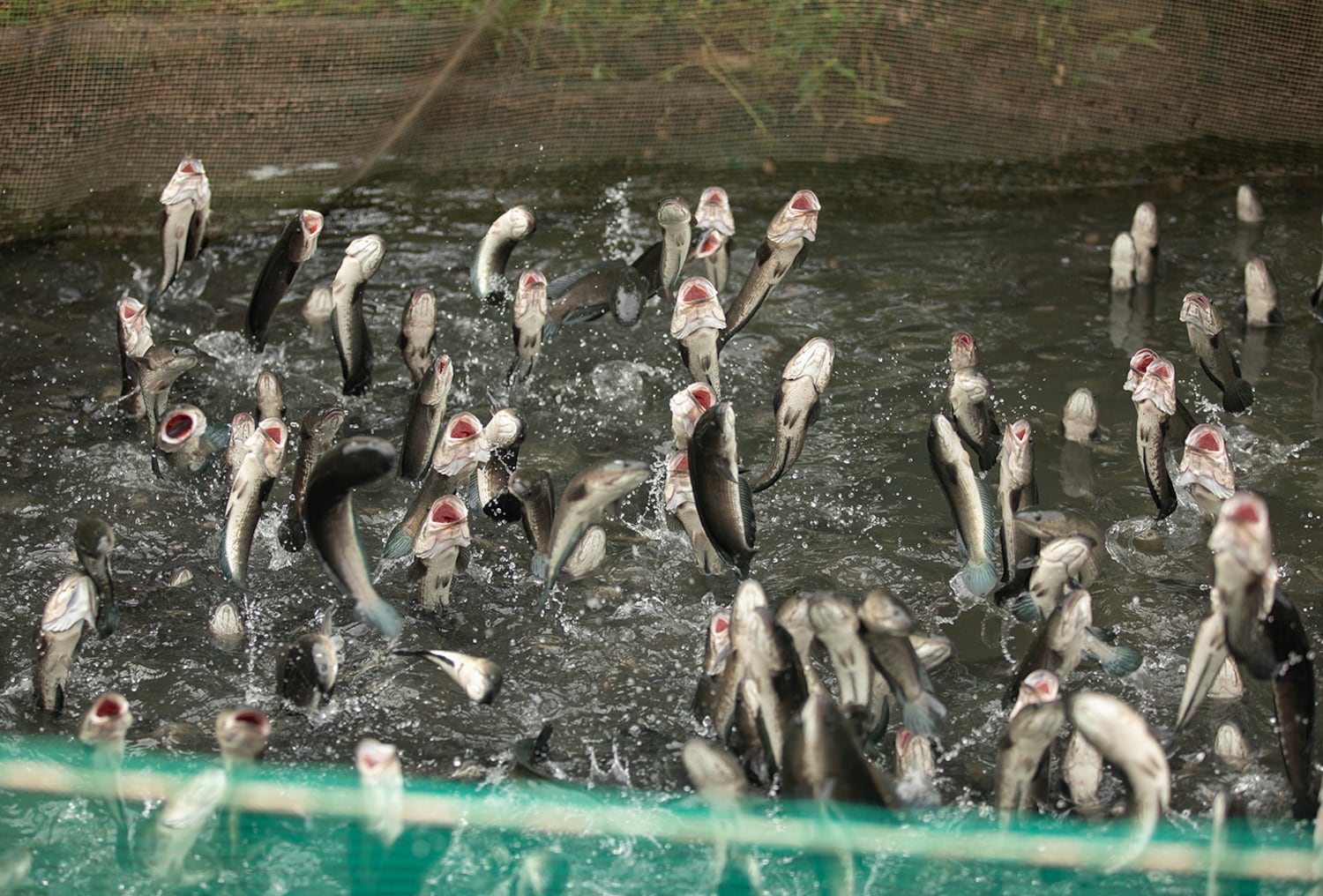
The Mekong River supports millions of people along its 4,300-kilometer (2,700-mile) path from its headwaters in the Tibetan Plateau through Southeast Asia and eventually into the South China Sea.
But its size and the politics of shared management has made it particularly susceptible to plastics pollution.
Globally, the Mekong river is among the waterways most responsible for such waste reaching the world’s oceans. The waste isn’t simply unsightly. Plastic pollution threatens thousands of species that rely on a free-flowing river while human consumption of microplastics poses a growing health concern.
Many hoped that a United Nations-led Global Plastic Treaty would ease the plastic pressures on rivers, but disagreements over plastic production and chemical use left the supposed landmark treaty unsigned earlier this month.
Negotiators now look to the sixth meeting, scheduled for sometime next year, to finalize the treaty. But even if a deal is closed, it may still be years before tangible solutions reach Mekong nations.
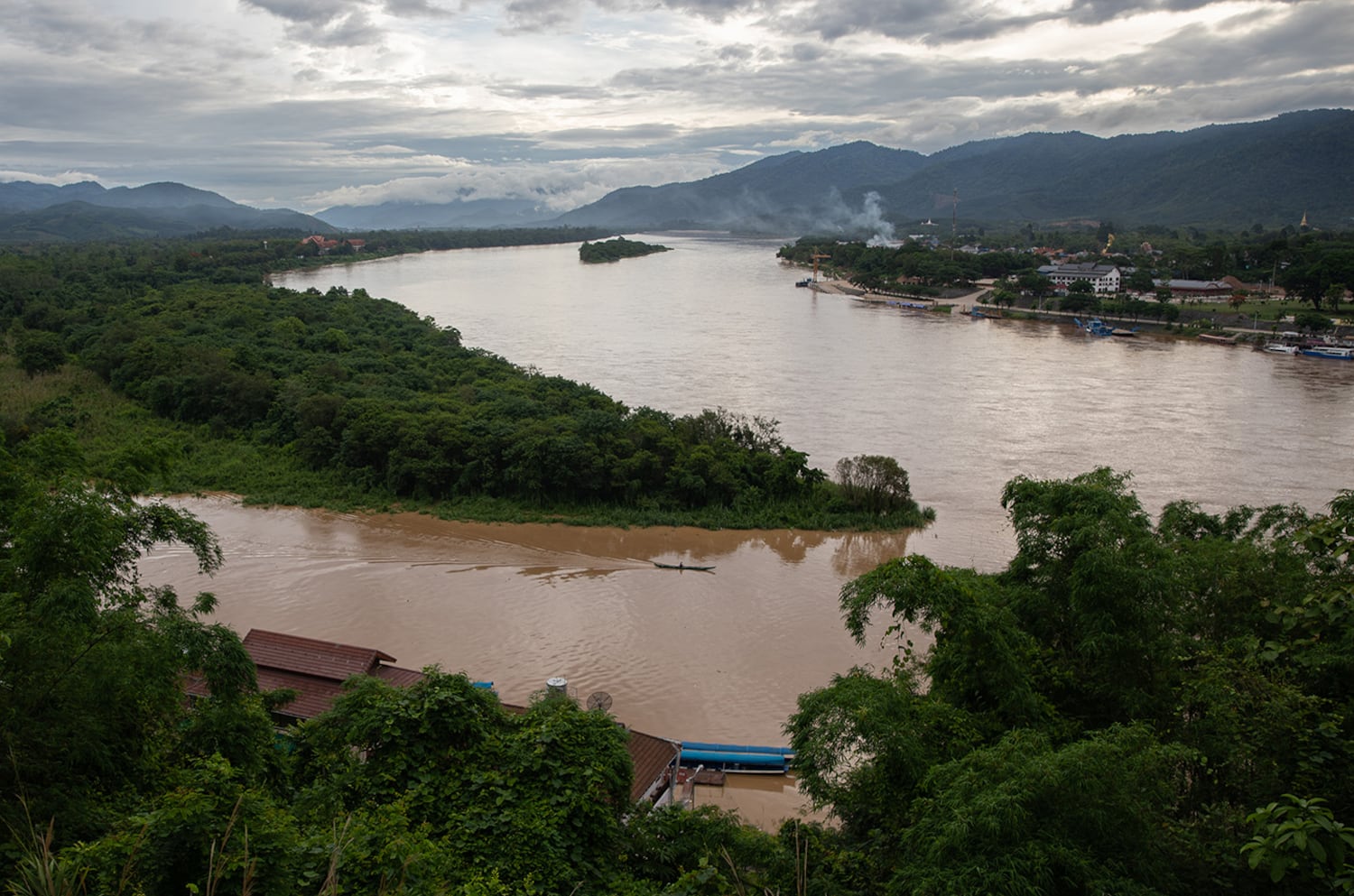
In the meantime, many living along the Mekong are not waiting for global action.
Four plastic waste hotspots along the Mekong’s lower basin — Chiang Saen in Thailand, Phnom Penh and Tonle Sap lake in Cambodia and Can Tho in Vietnam — illustrate the efforts being made to address plastic pollution but also the ways plastic is changing the lives of river communities dependent on these waters.
“We’re addicted to plastics, now more than ever,” says Panate Manomaivibool, an assistant professor at Thailand’s Burapha University who has studied plastic waste in the Mekong’s transboundary regions. “Compared to the scale of the problem, attempts to fix it are tiny.”
THAILAND, MYANMAR AND LAOS | The Golden Triangle of the Mekong River
While the entire upper basin of the Mekong River flows through China, where the waterway is known as the Lancang, the Golden Triangle region between Thailand, Myanmar and Laos acts as the gateway to the lower basin.
The meanderings of the Mekong across these three countries act as a politically recognized natural border between nations, showcasing the Mekong’s transboundary nature and the politics involved in managing such a natural resource.


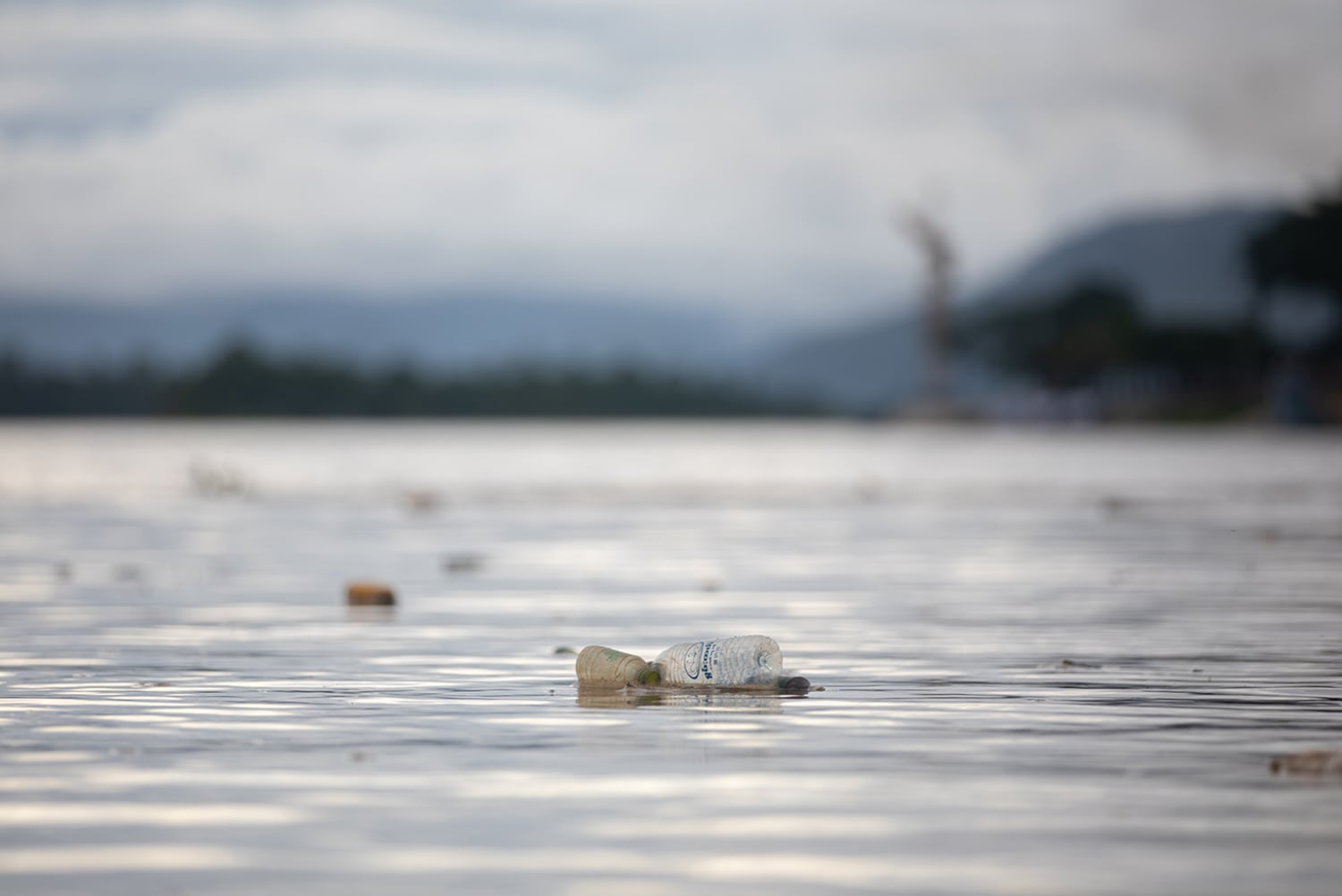
CAMBODIA | The ‘beating heart’ of the Mekong basin
After winding its way past Myanmar and between Thailand and Laos, the Mekong flows into Cambodia.
The nation’s capital Phnom Penh is situated at the confluence of the Mekong and its tributaries, the Bassac and Tonle Sap rivers. More than 100 kilometers (60 miles) northwest is the great Tonle Sap lake, known as “the beating heart of the Mekong” because of its unique flood pulse.
Rains from the annual monsoon season from May to October swell the size of the lake to roughly five times its usual size. The force of this flood reverses the direction of the Tonle Sap river, which is the only waterway in the world with this natural phenomenon. When the water level drops during the dry season, the river reverses once again.
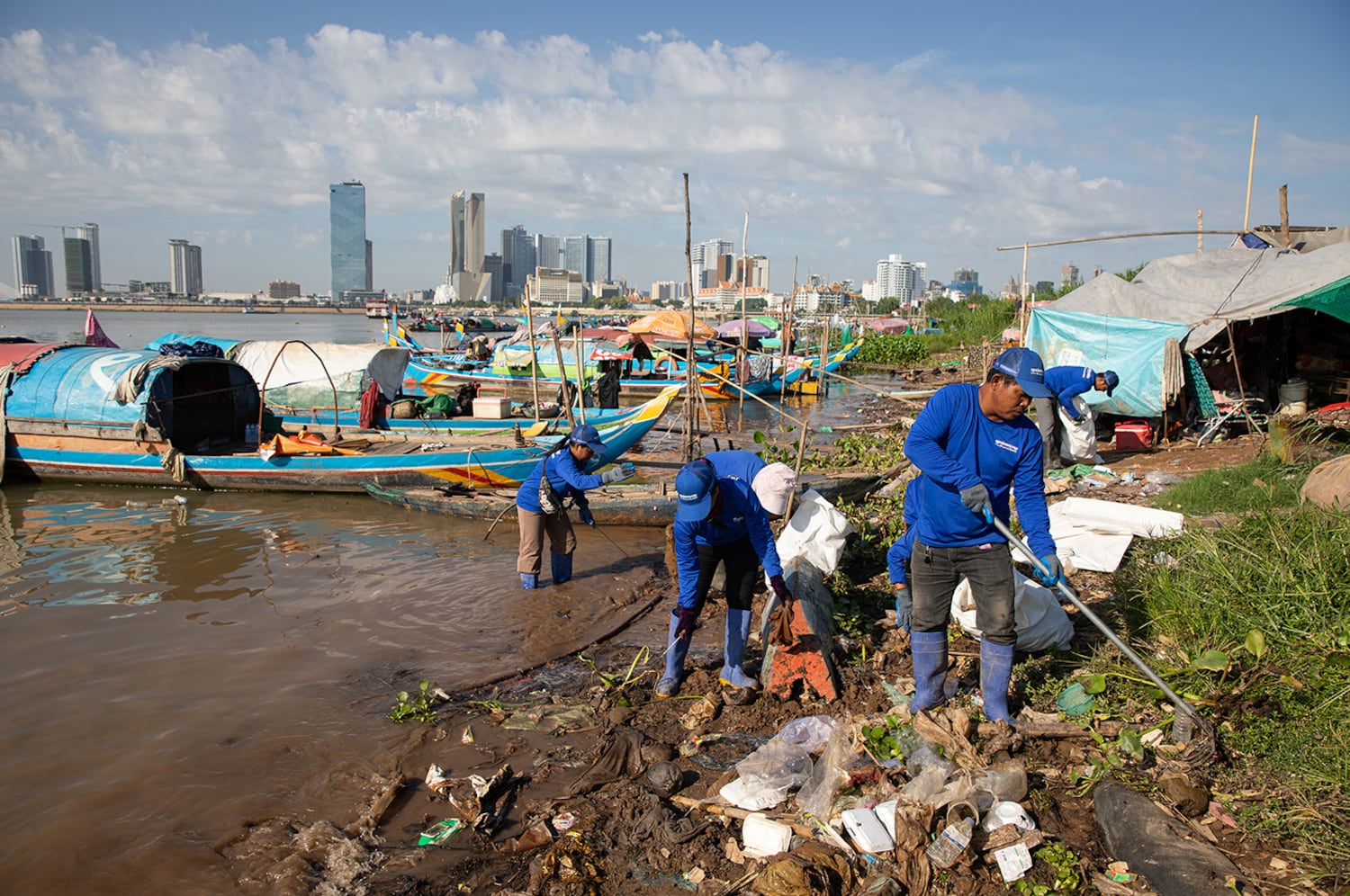
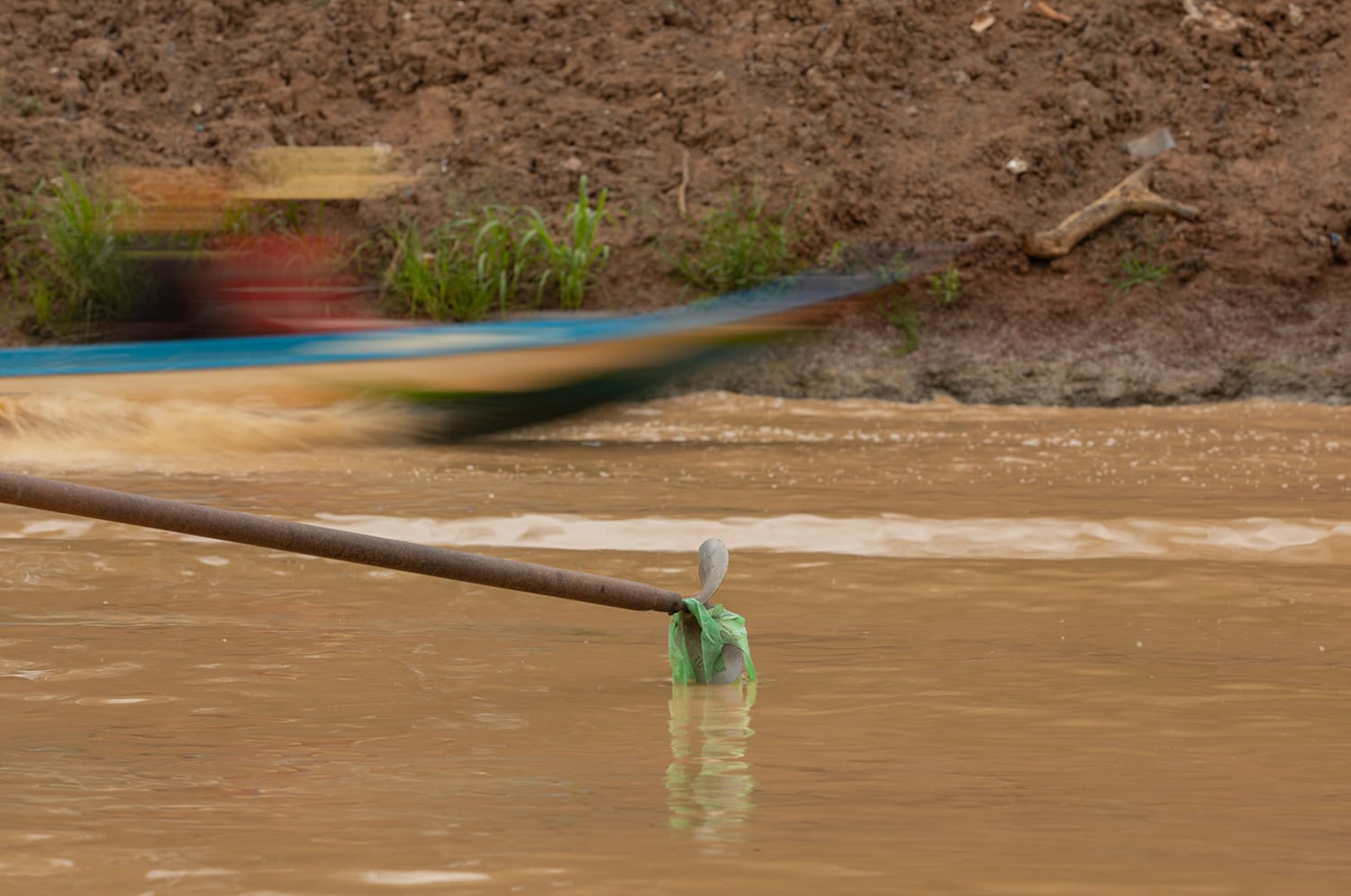

VIETNAM | Where the Mekong meets the sea
Past Phnom Penh, the Mekong flows south to the Cambodia-Vietnam border and eventually reaches through the urban sprawl of Ho Chi Minh City.
Here, the mainstem of the Mekong River branches out into tributaries, swamps, and islands to create the Mekong Delta, known as Vietnam’s “rice bowl.” Nutrients flowing in from the Mekong have made the region’s fertile farmland part of a multimillion-dollar rice industry. But with plastics following the same path, those farms face increasing threat.
The delta’s largest city, Can Tho, has now become the epicenter for the region’s waste issues.



Funding for this reporting was provided by Dialogue Earth, an independent environmental reporting and analysis nonprofit. RFA retains full editorial control of the work.
This content originally appeared on Radio Free Asia and was authored by RFA Investigative.
This post was originally published on Radio Free.
The British Museum’s use of the term “Xizang” to label Tibetan artifacts in its Silk Roads exhibition has prompted criticism from Tibetans and rights groups who have demanded that the museum remove the Beijing-promoted term and issue a formal apology.
Using “Xizang” — a term China formally adopted in 2023 in all its official documents to refer to Tibet — plays into Beijing’s attempts to undermine and erase Tibet’s historical and cultural identity, advocates say.
Instead, they demand that the London museum use “Tibet” exclusively.
Earlier this year, the French museum Musée du Quai Branly-Jacques Chirac also came under fire using the term in its exhibit. In October, the museum said it would undo the change in its exhibits, following weeks of protests and petitions by Tibetans.
‘Inaccurate and deeply offensive’
The British Museum’s Silk Roads exhibition, which explores the history of the ancient trade route during the key period from 500 to 1000, features over 300 objects from the museum’s own collection and those loaned from at least 29 other institutions.
The exhibit opened in late September and runs until Feb. 23, 2025.
On its labels and in catalogue materials describing Tibetan artifacts, the British Museum has used the phrase “Tibet or Xizang Autonomous Region.”
For example, a silver vase gifted by the 7th-century Tibetan Empire ruled by King Songtsen Gampo to neighboring Tang China was labeled as “Tibet or Xizang Autonomous Region, China.”
Tsering Passang, founder and chairman of the Global Alliance for Tibet and Persecuted Minorities, said use of “Xizang” is “not only inaccurate but deeply offensive to Tibetans.”
“It mirrors the Chinese Communist Party’s efforts to erase Tibet from the global map, rewrite its history, and suppress the Tibetan people’s peaceful culture,” he said.
Tibetan groups — led by advocacy group Global Alliance for Tibet and Persecuted Minorities and the Tibetan Community in Britain — wrote to the British Museum, first on Nov. 25 and later on Dec. 18, citing their grave concerns about use of the term.
RELATED STORIES
French museum blasted for using ‘Xizang’ in Tibet exhibits
China replaces ‘Tibet’ with ‘Xizang’ in latest diplomatic documents
Reject Tibet name change, leader of Tibet’s government-in-exile says
Nepal’s leader visits Beijing, joint statement uses ‘Xizang’ to refer to Tibet
The British Museum, in its response to initial complaints filed by the Tibetan groups, defended its use of the term Xizang, saying it “reflects the contemporary region,” according to a statement by the Global Alliance for Tibet and Persecuted Minorities.
Tibetan activists, however, have rejected the museum’s explanation, saying it ignores the political implications of promoting terminology perpetuated by the Chinese Communist Party that legitimizes the Chinese state narrative.
The British Museum did not immediately respond to RFA’s request for comment.
But later Beijing replaced the use of the term “Tibet” with “Xizang” in all official diplomatic documents, with Chinese official experts saying the name “Tibet” has been geographically misleading to the international community, and rectifying it “will help enhance China’s international voice on Tibet.”
The TAR borders India, Nepal and Bhutan to the south and spans more than 1.2 million square kilometers (460,000 square miles), making it China’s second-largest province-level division after the Xinjiang Uyghur Autonomous Region to the north — which Uyghurs prefer to call “East Turkistan.”
Shaping global understanding
Tibetan activists say the British Museum, which is funded by U.K. Department for Culture, Media and Sport and whose permanent collection of over 8 million items is among the largest in existence — “bears a profound responsibility to present history and heritage with integrity.”
“This is not just about labels; it’s about the museum’s role in shaping global understanding of a culture that is actively being suppressed,” said Phuntsok Norbu, chairman of the Tibetan Community in Britain.
The group has also urged the British Museum to engage in dialogue with Tibetan scholars and community leaders to ensure the accurate representation of Tibetan history and culture in future exhibitions.
Tibetans in France have also been protesting against Paris’ Musée Guimet, which has one of the largest collections of Asian art outside of Asia, saying it had kowtowed to Chinese pressure in referring to its Tibetan section as the “Himalayan World.”
Additional reported by Dickey Kundol. Edited by Tenzin Pema for RFA Tibetan and by Roseanne Gerin and Malcolm Foster.
This content originally appeared on Radio Free Asia and was authored by Loboe Socktsang and Tenzin Pema for RFA Tibetan.
This post was originally published on Radio Free.
The discovery of 46 illegal wells dug by Chinese migrants in the far western region of Xinjiang has intensified tension with Uyghur residents and disrupted the ecological balance of the region, people with knowledge of the situation told Radio Free Asia.
Fighting over water resources has been a source of friction for years between native Uyghurs and Chinese settlers in areas under the control of the state-run Xinjiang Production and Construction Corps, or XPCC, called Bingtuan in Chinese.
Authorities investigated after residents in Korla, or Kuerle in Chinese, the second-largest city in Xinjiang, complained about the proliferation of wells on the outskirts of the city, a source in Xinjiang said, asking not to be identified for security reasons.
The wells, dug to grow cotton and vegetables, have drained vital underground reserves, he said.
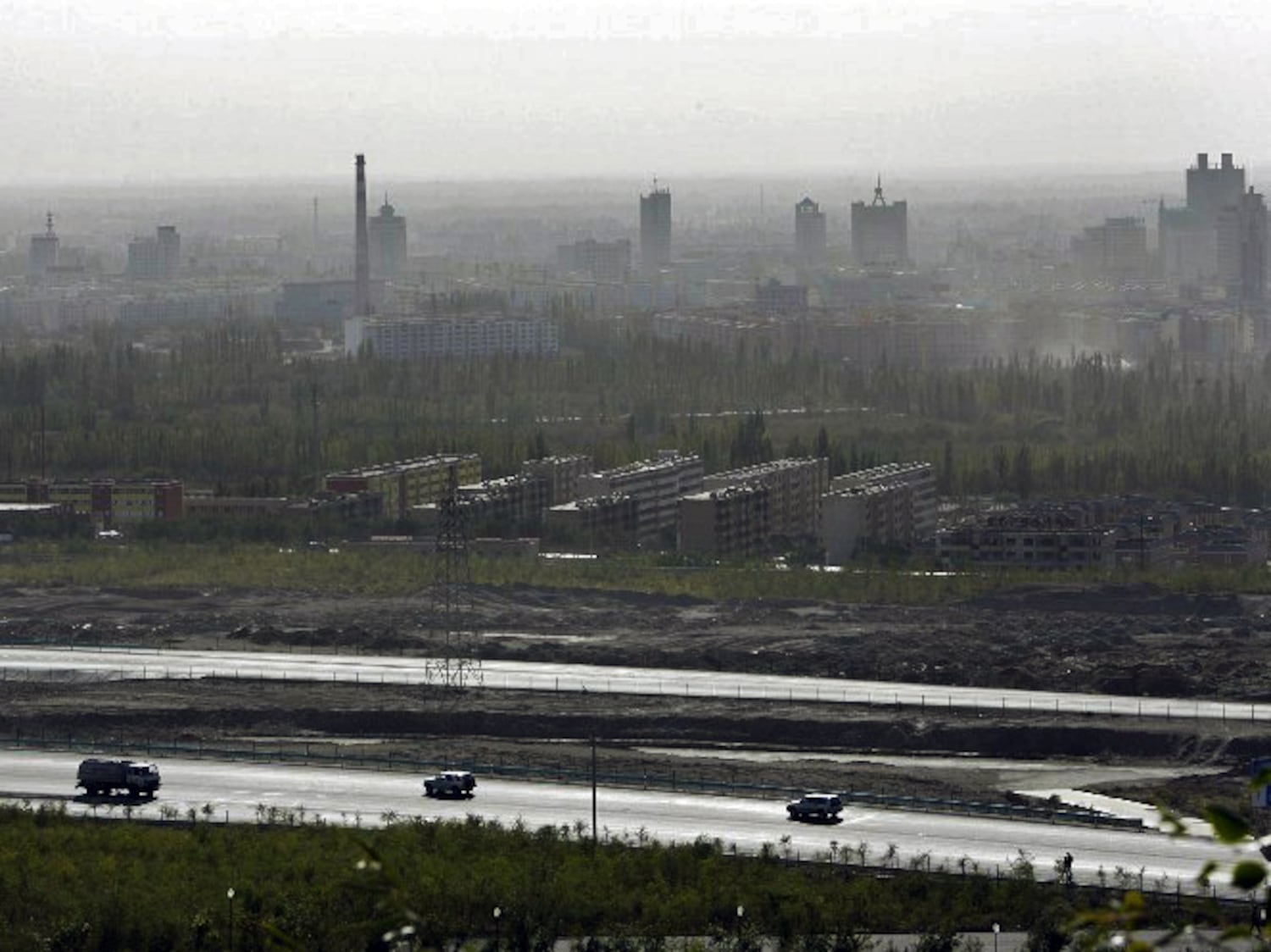
As a result, authorities discovered 46 illegally drilled holes this year alone in Korla, a policeman in Bayingholin prefecture’s Public Security Bureau who had participated in this case in its early phase told Radio Free Asia.
The residents accused of drilling the holes without a permit are from the 29th Battalion of the Bingtuan’s 2nd Division and Chinese settlers living in an economic development region on the outskirts of Korla, the officer said.
“We have been working on water management, water control, and identifying water wells since February, and we continue to work on those issues,” the police officer said.
Little accountability
But legal authorities have slowed down reviewing the cases, and the suspects were released after brief questioning, the Uyghur source said, with officials using “stability” and “unity” as excuses to let them go.
RELATED STORIES
Chinese irrigation tunnel project in Xinjiang hits snag: too much water
Subsidies for Han settlers ‘engineering demographics’ in Uyghur-majority southern Xinjiang
More than 1 million lack clean water in Xinjiang’s Hotan prefecture
Xinjiang’s capital Urumqi faces water crisis fueled by migration
Authorities could not hold all perpetrators accountable because the activities likely involved Han Chinese, he said.
The Bingtuan is a state-run economic and paramilitary organization of mostly Han Chinese who develop the land, secure borders and maintain stability in the Xinjiang Uyghur Autonomous Region, or XUAR, where about 12 million mostly Muslim Uyghurs live.
Made up of 14 divisions, the Bingtuan is one of the foremost institutions of Han dominance and marginalization of Uyghurs and other indigenous ethnic groups in the region, according to the Uyghur Human Rights Project.
The well-drilling began in 2012 when demand for cotton surged, the Uyghur source told RFA.
Those who stole the water conducted their activities at night using advanced technology to pump it from a depth of 200 meters, or about 660 feet, he said.
“Since they drill these wells in a forested area, a place that people hardly go, it was hard to discover their illegal activities,” the Uyghur source said.
It costs about 150,000 yuan (US$20,600) to drill a well and make it operational, he said, an amount that Uyghurs would not likely be able to come up with.
Though the issue has sparked friction many times before, the government has protected the Han Chinese residents, he said.
The policeman initially said there were some Uyghurs among those held responsible, but when pressed for further information, he said most of those who drilled the illegal wells were Chinese who had settled in the area, including Bingtuan workers.
Staff at relevant government organization in Korla contacted by RFA declined to answer questions, but did not deny that Chinese settlers there had stolen water.
Drying up the land
The growing dependence on groundwater in the Korla area since the 1990s has reached a level that is disrupting the ecological balance, said the source familiar with the situation.
“We must control this or it will lead to a further decline in groundwater levels,” he said. “In some areas of our protective forests, the Euphrates poplars are withering and drying up.”
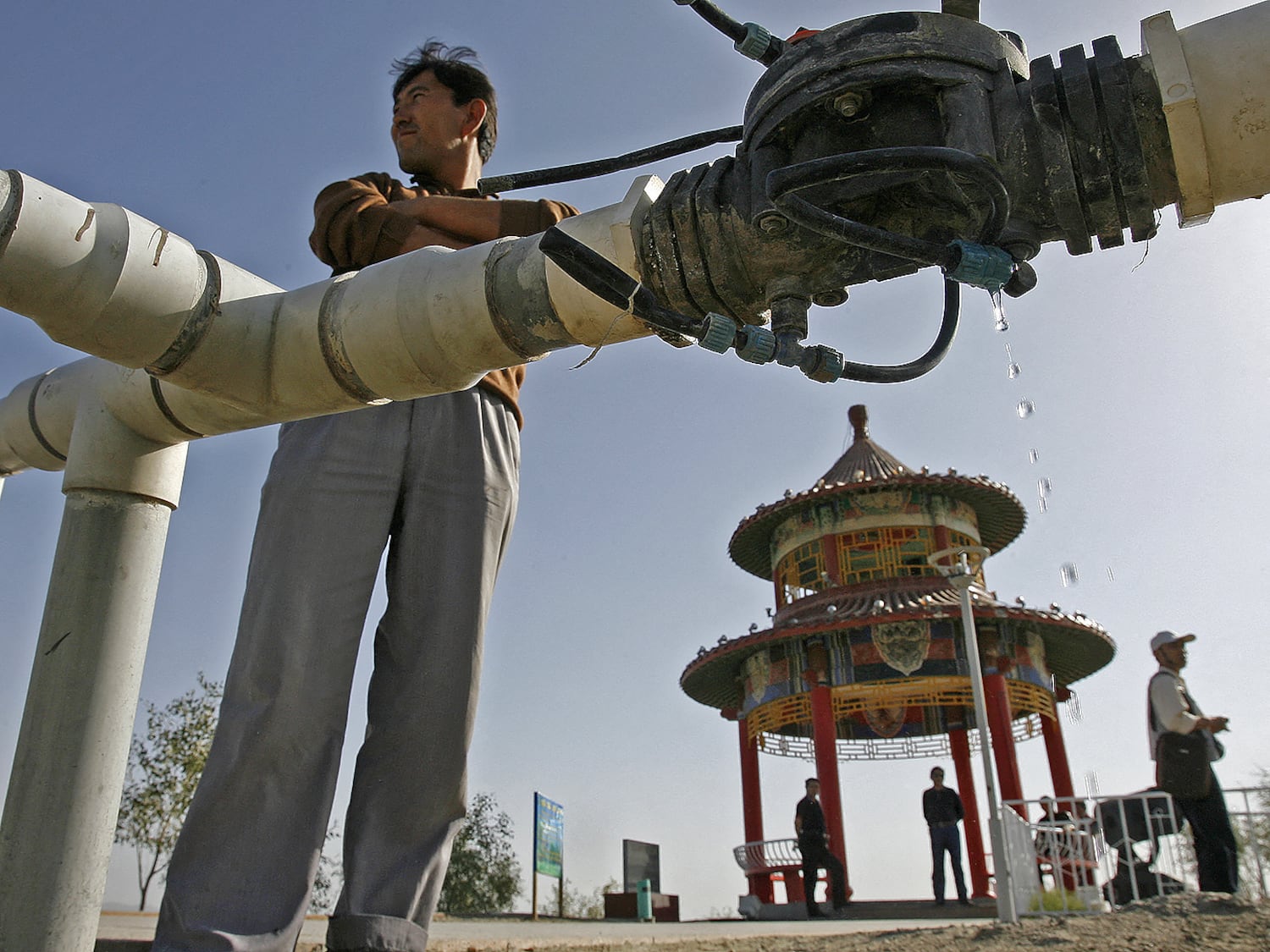
Peyzulla Zeydin, an ecological devastation researcher from Korla who now lives in the United States, told RFA that the misuse of water resources, including underground water, has severely impacted the region’s protective forests over time.
“In the 1990s, when we dug water wells, we could find water at just 10 meters,” he said. “Now, even at 30 meters, we can’t find water.”
“It’s getting worse because the underground water recycling system has been disrupted,” Zeydin said. “One of the main causes of the declining water levels is the growing population and the over-expansion of farmland. This has interrupted the natural underground water replenishment cycle.”
Zeydin said research indicates that the Bingtuan’s 1st Division battalions in the Korla area have overused and controlled the water resources there, leading to the drying up of Euphrates poplar trees along the lower streams of the Tarim River.
“The water level is dropping every day, and it has now reached a depth of 100 meters [330 feet],” he said.
Translated by RFA Uyghur. Edited by Roseanne Gerin and Malcolm Foster.
This content originally appeared on Radio Free Asia and was authored by Shohret Hoshur for RFA Uyghur.
This post was originally published on Radio Free.
This content originally appeared on The Grayzone and was authored by The Grayzone.
This post was originally published on Radio Free.
Comprehensive coverage of the day’s news with a focus on war and peace; social, environmental and economic justice.
The post The Pacifica Evening News, Weekdays – December 24, 2024 appeared first on KPFA.
This content originally appeared on KPFA – The Pacifica Evening News, Weekdays and was authored by KPFA.
This post was originally published on Radio Free.
This content originally appeared on Radio Free Asia and was authored by Radio Free Asia.
This post was originally published on Radio Free.
MANILA – The Philippines’ acquisition and deployment of a U.S. mid-range missile system is “completely legitimate, legal, and beyond reproach,” its defense chief said on Tuesday.
China protested against the plan by the Philippines to acquire a Typhon mid-range missile system from the United States to boost its maritime capabilities amid rising tensions in the disputed South China Sea.
Chinese foreign ministry spokesperson Mao Ning called the plan “provocative and dangerous,” and said on Monday it was an “extremely irresponsible choice” not only for the Philippine people and people of all Southeast Asian countries, but also “to history and to regional security.”
Philippine Secretary of National Defense Gilberto Teodoro said any deployment for the security of the Philippines was its affair.
“The Philippines is a sovereign state, not any country’s ‘doorstep’,” Teodoro said in a statement.
He did not refer to the Chinese comment on the missile system but reiterated that the enhancement of Philippine defense capabilities was intended to serve its national interest and “not targeted against specific countries.”
“Any deployment and procurement of assets related to the Philippines’ security and defense fall within its own sovereign prerogative and are not subject to any foreign veto,” Teodoro said.
RELATED STORIES
Philippines ratifies defense pact with Japan, amid China tensions
China, Philippines trade accusations over South China Sea confrontation
Philippines enacts laws asserting maritime claims
China and the Philippines have been trading accusations of provocation and intimidation over escalating tensions in parts of the South China Sea that they both claim, especially near reefs that lie inside Manila’s exclusive economic zone, or EEZ, but are also claimed by Beijing.
“If the Chinese Communist Party is truly intent on reducing tensions and instability in the region, they should … stop their provocative actions … withdraw their illegal presence from the Philippines’ EEZ, and adhere to International Law,” said Teodoro, who also accused Beijing of building up a nuclear arsenal and ballistic missile capability.
Typhon system
On Monday, Philippine army chief Lt. Gen. Roy Galido – while delivering his year-end report to an audience of domestic and foreign journalists in Manila – confirmed that the army has endorsed a plan to acquire a mid-range missile system “to boost the country’s capability in protecting its territory.”
The mobile system, called Typhon, was deployed to the Philippines early this year as part of a joint military exercise with the U.S. military.
Chinese defense minister Dong Jun said in June the deployment was “severely damaging regional security and stability.”
The missile system, developed by U.S. firm Lockheed Martin, has a range of 480 kilometers (300 miles), and is capable of reaching the disputed Scarborough Shoal as well as targets around Taiwan.

Galido said that the Typhon would “protect our floating assets,” referring to Philippine navy and coastguard vessels.
The acquisition is taking place as the army is “tasked to come up with plans to contribute to the comprehensive archipelagic defense,” according to Galido, who added that “one of our inputs is to be able to defend this land through this type of platform.”
Chinese spokeswoman Mao Ning criticized the plan, saying that the Philippines, “by bringing in this strategic offensive weapon, is enabling a country outside the region to fuel tensions and antagonism in this region, and incite geopolitical confrontation and arms race.”
BenarNews is an RFA-affiliated online news organization.
Edited by Mike Firn.
This content originally appeared on Radio Free Asia and was authored by RFA and BenarNews Staff.
This post was originally published on Radio Free.
This content originally appeared on Democracy Now! and was authored by Democracy Now!.
This post was originally published on Radio Free.
This content originally appeared on The Real News Network and was authored by The Real News Network.
This post was originally published on Radio Free.